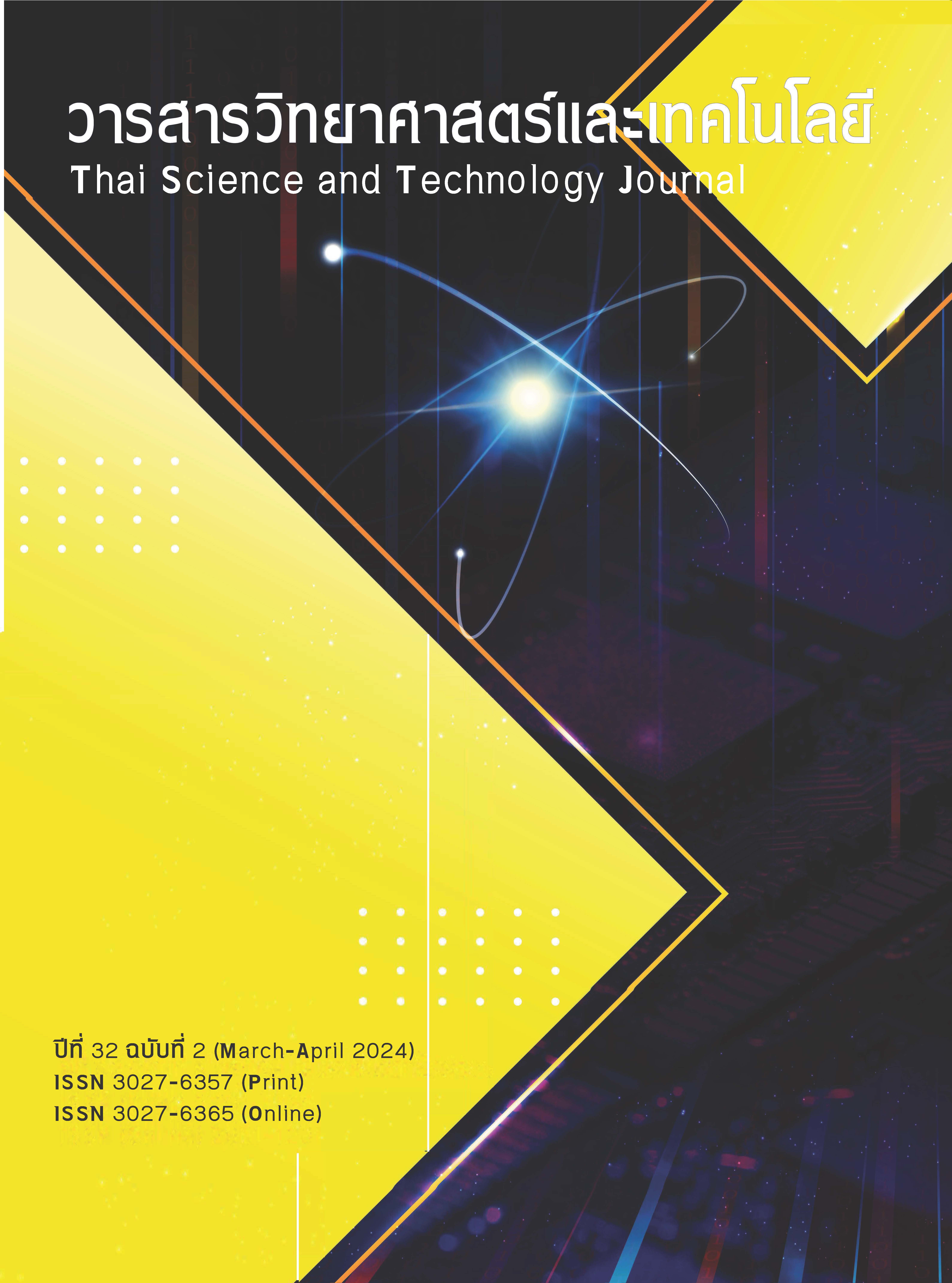Growth and Flesh Quality of Cobia Fed with Increased Lipid and Reduced Protein Diet and Increased Carbohydrate and Reduced Lipid Diet
Main Article Content
Abstract
Growth and flesh quality of cobia fed with increased lipid and reduced protein diets and increased carbohydrate and reduced lipid diets were determined. Test diets 1-4 contained protein/lipid/carbohydrate ratios of 40%/6%/31% (control), 36%/10%/33%, 36%/6%/36% and 36%/4%/38%, respectively. Groups of fish with an initial weight of 35 g were stocked in 3x3x2.5 M cage in Sri Racha Bay, Chonburi province, with stocking densities of 25 fish per cage and fed each diet to satiation once a day for 6 months. The results showed that the growth and feed conversion ratio of fish fed diet 1 were significantly better than those of fish fed diets 3 and 4 (p<0.05), but not significantly different from those of fish fed diet 2 (p>0.05). The protein efficiency ratio and flesh protein retention of fish fed diet 2 were significantly better than those fish fed other diets (p<0.05). There were no significant differences in condition factor, percentages of flesh and other organs, hepatosomatic and viscerosomatic indices among fish fed all test diets (p>0.05). The flesh protein contents of fish fed diets 1, 2 and 4 were not significantly different (p>0.05), but significantly higher than those of fish fed diet 3 (p<0.05). The flesh lipid contents of fish fed diets 1 and 3 were not significantly different (p>0.05), but significantly higher than those of fish fed diets 2 and 4 (p<0.05). From this study, it was observed that the cobia diet for 35-800 g could reduce protein from 40% to 36% calculated as a reducing rate of 10%, and increase lipid from 6 to 10%, calculated as an increase rate of 66.7%.
Article Details
References
Liao, I.C., Huang, T.S., Tsai, W.S., Hsueh, C.M., Chang, S.L. and Leaño, E.M., 2004, Cobia culture in Taiwan: current status and problems, Aquaculture. 237: 155-165.
Merican, Z., 2008, Cobia in idyllic central Vietnam, Aqua Culture Asia Pacific. 4(6): 25-26.
Nhu, V.C., Nguyen, H.Q., Le, T.L., Tran, M.T., Sorgeloos, P., Dierckens, K., Reinertsen, H., Kjørsvik, E. and Svennevig, N., 2011, Cobia Rachycentron canadum aquaculture in Vietnam: Recent developments and prospects, Aquaculture. 315: 20-25.
Chou, R.L., Her, B.Y., Su, M.S., Hwang, G., Wu, Y.H. and Chen, H.Y., 2004, Substituting fish meal with soybean meal in diets of juvenile cobia Rachycentron canadum, Aquaculture. 229: 325-333.
Mock, T.S., Francis, D.S., Jago, M.K., Glencross, B.D., Smullen, R.P., Keast, R.S.J. and Turchini, G.M., 2019, The impact of dietary protein: lipid ratio on growth performance, fatty acid metabolism, product quality and waste output in Atlantic salmon (Salmo salar), Aquaculture. 501: 191-201.
Li, X.F., Liu, W.B., Jiang, Y.Y., Zhu, H. and Ge, X.P., 2010, Effects of dietary protein and lipid levels in practical diets on growth performance and body composition of blunt snout bream (Megalobrama amblycephala) fingerlings, Aquaculture: 303: 65-70.
AOAC, 2016, Official Methods of Analysis of AOAC International. 20th Ed., Association of Official Analytical Chemists, Maryland, USA, 3172 p.
Duangsawasdi, M. and Somsiri, J., 1985, Water Quality and Analysis Method for Fisheries Research, National Inland Fisheries Institute, Department of Fisheries, Bangkok. (in Thai)
Nash, R.D.M., Valencia, A.H. and Geffen, A.J., 2006, The origin of Fulton’s condition factor-setting the record straight, Fisheries. 31(5): 236-238.
FAO, 1987, The Nutrition and Feeding of Farmed Fish and Shrimp - A Training Manual, Available Source: https://www.fao.org/3/ab470e/AB470E00.htm, Oct 23, 2023.
Boonyaratpalin, M., Suraneiranat, P. and Tunpibal, T., 1998, Replacement of fishmeal with various types of soybean products in the diets for the Asian seabass, Lates calcarifer, Aquaculture. 161: 67-78.
Department of Fisheries, 2018, Criteria for Consideration on Registering Marine Carnivorous Fish Feed, Available Source: http://www4.fisheries.go.th/local/file-document/20161129160413_file.pdf, Sep 25, 2023. (in Thai)
Craig, S.R., Schwarz, M.H. and McLean, E., 2006, Juvenile cobia (Rachycentron canadum) can utilize a wide range of protein and lipid levels without impacts on production characteristics, Aquaculture. 261(1): 384-391.
Chueapohak, W., 2000. Aquatic Animal Nutrition and Feeding Aquatic Animal, 2nd Ed., Kasetsart University Press, Kasetsart University, Bangkok, Thailand, 255 p. (in Thai)
Yuru, Z., Ronghua, L., Chaobin, Q. and Guoxing, N., 2020, Precision nutritional regulation and aquaculture, Aquac. Rep. 18: 100496.
Zhao, H., Cao, J., Chen, X., Wang, G., Hu, J. and Chen, B., 2020, Effects of dietary lipid-to-carbohydrate ratio on growth and carbohydrate metabolism in juvenile cobia (Rachycentron canadum), Anim. Nutr. 6(1): 80-84.
Taj, S., Irm, M., Jin, M., Yuan, Y., Andriamialinirina, H.J.T. and Zhou, Q., 2020, Effects of dietary carbohydrate to lipid ratios on growth performance, muscle fatty acid composition, and intermediary metabolism in juvenile black seabream (Acanthopagrus schlegelii), Front. Physiol. 11: 507.


